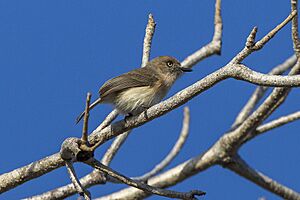Archbold's newtonia facts for kids
Quick facts for kids Archbold's newtonia |
|
|---|---|
 |
|
| Conservation status | |
| Scientific classification | |
| Genus: |
Newtonia (bird)
|
| Species: |
archboldi
|
The Archbold's newtonia (Newtonia archboldi) is a small bird that lives only on the island of Madagascar. It's part of the Vangidae bird family. These birds like to live in dry forests and shrublands.
Archbold's newtonias have a greyish-brown back and tail. Their forehead is a reddish-brown color. Their belly, throat, and the feathers under their tail are a creamy white. They have a bright reddish-brown ring around their eyes, which makes them easy to spot! They also have a black beak and pale yellow eyes. Male and female Archbold's newtonias look very similar.
This bird mainly eats insects and other small creatures like spiders. They usually find their food on twigs and leaves. Sometimes, they look for food on tree bark or on the ground. They build a cup-shaped nest in shrubs. A female usually lays three reddish-white eggs with light brown spots.
The bird is named after Richard Archbold, an explorer and bird expert.
Contents
About the Name
The Archbold's newtonia is the only bird of its kind (it's "monotypic"). Its scientific name, archboldi, honors an American zoologist named Richard Archbold. He was part of a special team that discovered this bird in Madagascar.
What It Looks Like
This is a small bird with short wings and long legs. It has a short, thin beak. An Archbold's newtonia is about 12 cm (4.7 in) long. It weighs around 7.2–8.3 g (0.25–0.29 oz), which is very light! Its beak is about 13.5 mm (0.53 in) long.
The top of its head and its upper body are greyish-brown. The front part of its head has a reddish-brown tint. It has a noticeable dark reddish-brown ring around its eyes. Its chin, throat, belly, and the feathers under its tail are a creamy white. Its chest and sides are a cinnamon-buff color. The cheeks and ear areas are greyish-brown, and its tail is grey-brown. It has a black beak and pale yellow eyes.
Young Archbold's newtonias have less reddish-brown on their heads. Their wing feathers also have reddish-brown tips.
How It Sings
Archbold's newtonias usually sing from hidden spots. Their calls are described as quick, strong, and low-pitched whistles. Their songs are unique and change a bit from bird to bird. They can sound like "tee-too tekhew" or "chichichich wit-tee tew." They also make a "tchiew" sound. These birds sing often, not just when they are nesting.
How It Lives
This bird spends most of its time in shrubs and low trees. It moves by hopping from branch to branch. It's not as social as some other newtonia birds. However, you might see it with groups of other insect-eating birds. It often travels in small family groups of 2 to 5 birds. These groups can be just newtonias or a mix of different bird species. Larger birds of prey, like France's sparrowhawk, might hunt them.
What It Eats
Archbold's newtonias are mainly insect-eaters. They eat almost only arthropods. Scientists have found spiders, beetles, true bugs, termites, caterpillars, and grasshoppers in their stomachs.
They look for food by themselves in the lower and middle parts of the forest. They are very active while hunting. They hop through branches of shrubs and trees. They pick their prey off twigs and leaves. Sometimes, they also find food on tree bark or on the ground.
How It Reproduces
These birds are thought to stay with one partner for life.
Nests have been seen in September, November, and December. They are usually about 0.95 m (3.1 ft) above the ground in shrubs. The nests are shaped like a cup. They are about 6 cm (2.4 in) wide, with an inside space of 4 cm (1.6 in) wide and 4 cm (1.6 in) deep. They are built using long, thin, dry leaf stalks. The outside of the nest is covered with dry leaves. The nest is held up by four thin twigs. Two twigs go through the nest, and two are attached with spider webs. The bottom of the nest doesn't rest on anything.
Female Archbold's newtonias lay clutches of 3 eggs. The eggs are about 15.7 mm × 11.4 mm (0.62 in × 0.45 in) in size. They are reddish-white with several pale brown spots around the wider end. Both the male and female birds help to incubate the eggs. Young birds are usually seen from November to December, and sometimes as late as May.
Where It Lives
This bird lives only in the southern part of Madagascar. It is mostly found near the coast. However, it can also be found further inland. It seems to have two separate groups of birds in southwestern and southeastern Madagascar. It usually lives below 100 m (330 ft) in height. But it can be found as high as 600 m (2,000 ft) on rocky mountains. It does not migrate and stays in its home area all year.
It mainly lives in spiny forests with plants like Didiereaceae, Euphorbia, and baobabs. It also lives in nearby scrubby areas. It is not common in coastal Euphorbia forests. It can also live in damaged deciduous broadleaved forest in the northern parts of its range. Sometimes, it lives in coastal forests in southeastern Madagascar.
Its Conservation Status
The IUCN has assessed this species as "least concern." This means it is not currently in danger of disappearing. It is quite common throughout the areas where it lives. The forests where it lives in southern Madagascar have been cut down a lot. However, the number of Archbold's newtonias seems to be staying steady.


